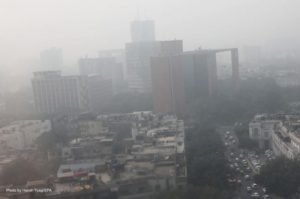 A new study led by researchers at the Columbia Center for Children’s Environmental Health (CCCEH) organizes the available scientific evidence on the effects of air pollution on children’s health. The paper in the journal Environmental Research is the first comprehensive review of the associations between various pollutants present in tailpipe emissions from diesel powered vehicles and the resulting multiple health effects in children. The context is the assessment of the potential benefits of policies for reducing air pollution and climate change.
A new study led by researchers at the Columbia Center for Children’s Environmental Health (CCCEH) organizes the available scientific evidence on the effects of air pollution on children’s health. The paper in the journal Environmental Research is the first comprehensive review of the associations between various pollutants present in tailpipe emissions from diesel powered vehicles and the resulting multiple health effects in children. The context is the assessment of the potential benefits of policies for reducing air pollution and climate change.
The researchers say their goal was to expand the series of child health outcomes addressed by programs to assess health and economic benefits, such as the Environmental Protection Agency (EPA) Benefits Mapping and Analysis Program (BenMAP), by identifying concentration-response (C-R) functions for six outcomes related to PM2.5, NO2, PAH, and/or PM10: preterm birth (PTB), low birthweight (LBW), autism, attention deficit hyperactivity disorder, IQ reduction, and the development of childhood asthma.
Tailpipe emissions of diesel powered vehicles, including particulate matter (PM2.5), polycyclic aromatic hydrocarbons (PAH), nitrogen dioxide (NO2) and carbon dioxide (CO2), are a significant threat to children's health and equality. Various policies to reduce emissions have been implemented to reduce air pollution and mitigate climate change, with sizeable estimated health and economic benefits. However, only a few adverse outcomes in children have been considered, resulting in an undercounting of the benefits to this vulnerable population.
“Policies to reduce fossil fuel emissions serve a dual purpose, both reducing air pollution and mitigating climate change, with sizable combined health and economic benefits,” says first author Frederica Perera, PhD, director of CCCEH and professor of Environmental Health Sciences. “However, because only a few adverse outcomes in children have been considered, policymakers and the public have not yet seen the extent of the potential benefits of clean air and climate change policies, particularly for children.”
The researchers reviewed 205 peer-reviewed studies published between January 1, 2000 and April 30, 2018 which provided information on the relationship between the concentration of exposures to air pollutants and health outcomes. The studies relate to fuel combustion by-products, including toxic air pollutants such as particulate matter (PM2.5), polycyclic aromatic hydrocarbons (PAH), and nitrogen dioxide (NO2). A table provides information on the risk of health outcomes for exposure by study, encompassing research on six continents.
Even though the study does not focus in the most common sources for these pollutants, it is well known that PM2.5 and smaller, PAH and NOx in urban areas result from the use of diesel powered transportation. The use of Natural Gas in heavy duty vehicles will help to reduce these contaminants, due to the fact that particulate matter, NOx and PAH are practically eliminated.
“There is extensive evidence on the many harms of air pollution on children’s health,” says Perera. “Our paper presents these findings in a convenient fashion to support clean air and climate change policies that protect children’s health.”
The World Health Organization has estimated that more than 40 percent of the burden of environmentally related disease and about 90 percent of the burden of climate change is borne by children under five, although that age group constitutes only 10 percent of the global population. The direct health impacts in children of air pollution from fossil fuel combustion include adverse birth outcomes, impairment of cognitive and behavioral development, respiratory illness, and potentially childhood cancer. As a major driver of climate change, combustion of fossil fuel is also, directly and indirectly, contributing to illness, injury, death, and impaired mental health in children through more frequent and severe heat events, coastal and inland flooding, drought, forest fires, intense storms, the spread of infectious disease vectors, increased food insecurity, and greater social and political instability. These impacts are expected to worsen in the future.
The study was co-authored by Adiba Ashrafi of CCCEH; Patrick Kinney of Boston University; and David Mills of Abt Associates, Boulder, Colorado; with funding from the Rockefeller Foundation Fellowship Program and the John Merck Family Foundation.
